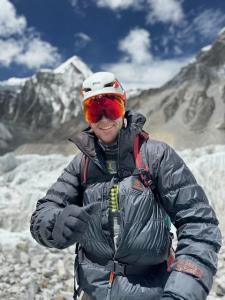
New World Record - Andrew Ushakov Completes Everest Mission from Sea Level to Summit in Under 4 Days
US man breaks world record despite broken arm; Not a pro-athlete or with a military background; Most mountaineers take 50+ days
Andrew did hypoxic training beforehand as part of his mission preparation - spending 400+ hours in a hypoxic tent to help with acclimatization. His challenge started from sea level at 00:30 on Thursday May 15 when he flew from New York to Kathmandu, and then on to Everest base camp. He then climbed to the summit, arriving at 09:22 on Monday May 19 (local time).
Andrew summited the world’s highest peak without acclimatization and despite having broken his arm in seven places during a recent avalanche. Having been signed off by doctors, his motivation was not just to summit, but for medical science and to benefit the wider climbing community. He also did not use Xenon gas, which is used by some climbers as a way to speed up acclimatization at high altitudes.
A relative unknown in the mountaineering world, Andrew Ushakov’s regular job is as a full time manager and engineer. As well as being a married father of one, he describes himself as a ‘regular guy with an office job’.
Commenting on his achievement, Andrew says, “I’m ecstatic, although physically exhausted, to have achieved what many people in the mountaineering world said was impossible. I hope this shows that you don’t have to be a professional athlete or a full-time adventurer to do something extraordinary. You can hold down a job, raise a family, and still accomplish something that pushes the limits of what you thought was possible. I did this as a regular guy, with a broken arm and a dream. This is for the 99% of people out there who think big goals are off limits. My message is that if you want to achieve your dreams - even if everyone else says it's impossible - just give it a try.”
Acclimatization is the primary reason why most climbers spend around 50 days on Everest — without it, the human body simply can’t survive at extreme altitude. To avoid a long expedition away from his family and business, Andrew used a hypoxic tent at home to simulate high-altitude conditions, a method used by elite athletes to pre-adapt to reduced oxygen levels.
During Andrew’s previous challenge in May 2024, he had to turn back 300 metres from the summit due to experiencing temporary blindness. And despite his more recent broken arm, Andrew was driven to achieve his personal goal of a fast five day ascent of Mount Everest, motivated by a desire to balance his climbing ambition with his responsibilities at home and work.
Andrew’s team included four Everest guides from Elite Exped, including his 1:1 guide Tejan ‘TJ’ Gurung. TJ, who is the youngest British male to climb the 14 Peaks, said, “I’m really proud of Andrew’s determination and drive. To come back from injury and set back in the way he has, shows huge strength of character and mental resilience. I’m proud to stand on the summit of Everest with you Andrew, you deserve this success.”
Andrew’s physical feat will provide important data and research into the challenges on the body of altitude. In another first, before his ascent, Andrew swallowed a special biometric tablet linked to a smart watch and satellite phone to download real-time data about his health vitals to see what transformations his body goes through. Overseen by Professor Yannis Pitsialdis, Professor of Sport and Exercise Science at the International Olympic Committee’s Medical and Scientific Commission, who said, “This isn’t just a record attempt. It’s a testbed for future medical and athletic safety in extreme environments.”
www.EverestSeaToSummit.com
ends
Sarah Lloyd-Morrison
Magenta pr
+44 7971 411212
sarah@magentapublicrelations.co.uk
Visit us on social media:
Instagram
Distribution channels: Sports, Fitness & Recreation
Legal Disclaimer:
EIN Presswire provides this news content "as is" without warranty of any kind. We do not accept any responsibility or liability for the accuracy, content, images, videos, licenses, completeness, legality, or reliability of the information contained in this article. If you have any complaints or copyright issues related to this article, kindly contact the author above.
Submit your press release
